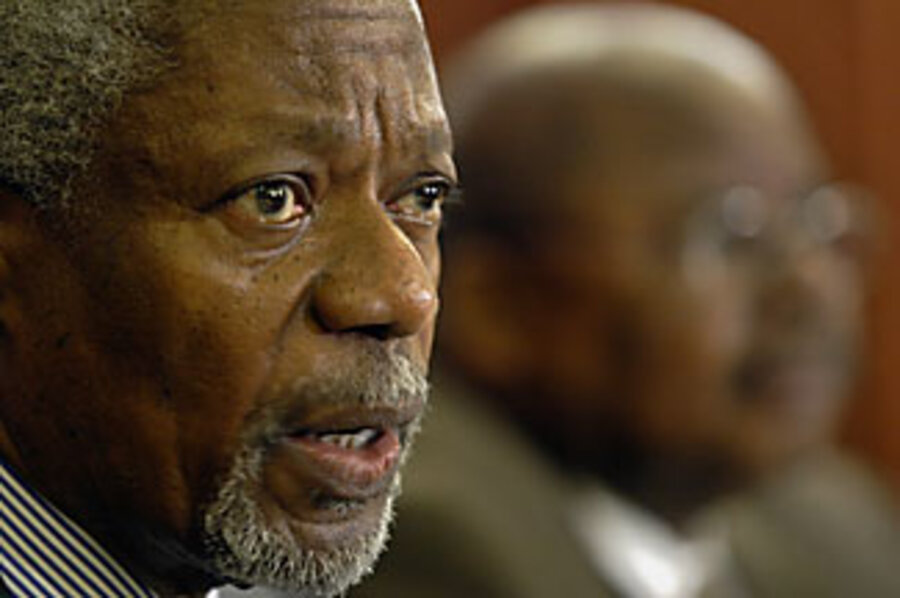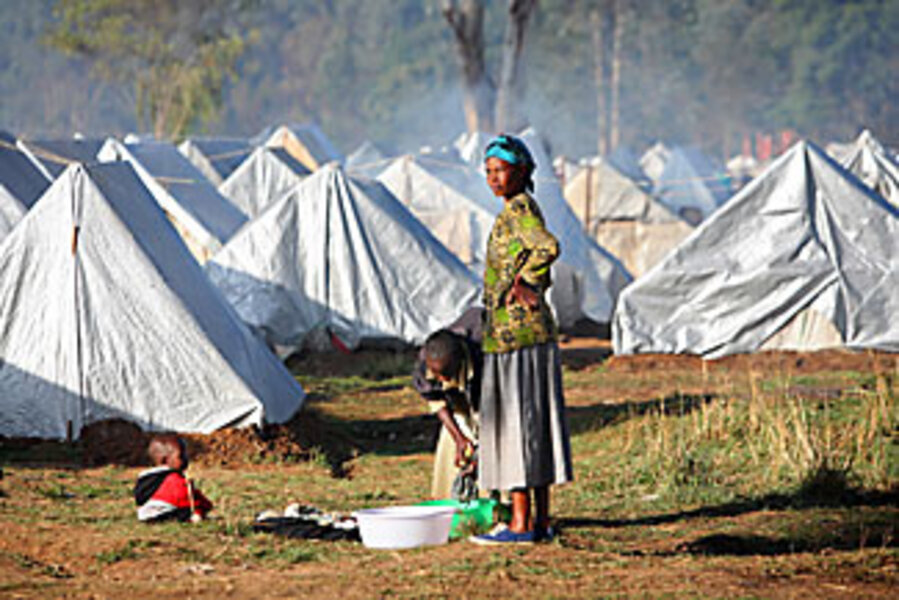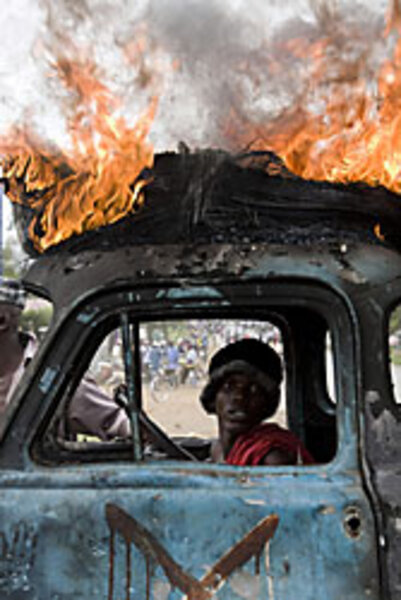For Kenya, a month of attacks, then quick progress
Loading...
| Nairobi, Kenya
In the first few days following the Dec. 27 election, many Kenyans didn't realize – or didn't accept – that they had a problem. Horrific ethnic violence – Kalenjins and Luos attacking Kikuyus – flared in the Rift Valley and western Nyanza provinces. But many African academics, aid workers, and politicians in Nairobi predicted that the "disturbances" would last for just a few days, like a teakettle letting off steam.
Ensconced in the State House – the official presidential residence – President Mwai Kibaki continued to insist that the Dec. 27 elections were legitimate and he'd been reelected. International observers called the elections "flawed." The opposition, holed up in their own headquarters (ominously dubbed "the Pentagon"), continued to cry foul, and to urge for peaceful mass action. As each side claimed victory, the country burned.
"I don't know whether this was a fight over principles. This was a fight over power," recalls Martha Karua, a hard-liner in Mr. Kibaki's cabinet. "The election commission clearly declared Kibaki to be the winner, and the loser refused to accept the result, and refused to accept the internationally accepted method for resolving the dispute: going to court."
In the initial aftermath of the elections, no one was talking to former UN secretary-general Kofi Annan. His role as chief mediator was the result of three weeks of concerted, behind-the-scenes effort by Kenyan diplomats, businessmen, and civil activists, as well as substantial pressure from the international community.
• • •
In his room at the Serena Hotel, a few days after the Dec. 27 elections, former Tanzanian President Benjamin Mkapa is packing his bags to leave. He has spent the past two weeks in Kenya as head of the Commonwealth Group election monitoring mission. The group has reported persistent vote irregularities, casting doubt on the election results. But his work as an electoral observer is done. Mr. Mkapa, with some sadness, is heading home.
Then, there's a knock on his hotel door. It's Lazaro Sumbeiywo, a retired Kenyan general, and Ambassador Bethuel Kiplagat, a Kenyan career diplomat, both of whom helped mediate an end to Sudan's 20-year civil war.
"You are not leaving," General Sumbeiywo tells Mkapa. "Now that we have got this problem, you will not leave. You have to get in touch with our leaders" to agree to international mediation.
"We held him hostage in this hotel," Sumbeiywo recalls, with a chuckle. He had no doubt that Kenya needed international intervention to resolve the political impasse. It would start with Mkapa. "What mattered to us was that we wanted to stop the mayhem and we wanted people to talk," he says.
Mkapa agrees to stay. That decision would prove to be a crucial first step to bringing in Annan, and the ultimate peace deal.
Using his credentials both as a former African president and as an election observer, Mkapa starts making phone calls to the diplomatic corps in Nairobi, and briefs John Kufuor, the African Union chairman and president of Ghana.
After the first week, it becomes clearer that the violence will not just peter out on its own. International pressure mounts in earnest. Secretary of Sate Condoleezza Rice and David Miliband, the British foreign secretary, issue a joint statement appealing for an end to the violence. A parade of African leaders, including Desmond Tutu and Ugandan President Yoweri Museveni, arrive to urge dialogue. President Kufuor arrives, too. Although the press calls his trip a failure, Mr. Kufuor manages on Jan. 10 to persuade both parties to start political dialogue with the help of a "Panel of Eminent African Personalities" appointed by the African Union.
The panel will be chaired by Annan. He will be joined by the "hotel hostage," Tanzanian President Mkapa, and former South African first lady Graça Machel.
But on the same day, President Kibaki swears in his cabinet. He's reminding everyone that if he negotiates with the opposition, he will do so from a position of strength.
Annan, staying abreast of events from his home in Geneva, packs and heads to the airport on Jan. 15. But he falls ill before his plane leaves, is hospitalized, and diagnosed with the flu. Another set-back. In the week leading up to his eventual arrival on Jan. 22, Kenya's death toll climbs to 1,000. On Jan. 28, the day before Ms. Machel dresses down the negotiators, an opposition parliamentarian is gunned down in his home. The opposition says that it's a political assassination.
Yet even such provocations won't derail the mediators now.
• • •
It's Feb. 1, and the Orchid Room of Nairobi's Serena Hotel is understandably tense. On one side of the table sits Odinga's four-person mediation team, and on the other side sits the four-person team of President Kibaki. Annan is at the head of the table, with a table of experts behind him, passing him notes. Machel and Mkapa – who will aid Annan in the early days of the mediation – are there as well, interjecting their views to keep the two teams focused. A team of note-takers and a technical staffer loaned to Annan sit at the end of the table, opposite Annan.
The Orchid Room – since renamed the "Amani Room" because of its role in the Kenyan peace process (amani means peace in Swahili) – is perfectly suited for the kind of pressure-cooker discussions that will take place here for the next five weeks. At one end of the boardroom is a small, private, walled-in patio where the mediation teams can take their tea breaks. At the other end is a door to the hallway, inevitably crowded with reporters.
Ruto is fiddling with his cellphone, reading text messages from constituents and family members in the Rift Valley, telling him about the spread of violence around Eldoret. Members of the president's team are receiving messages too, as their political supporters urge them to stand firm. Some, victims of attacks, are pleading for fast results.
But it is this tension – a sense of responsibility for the fate of a nation – that provides Annan with his first opportunity for progress. He knows that both sides want the violence to stop.
The discussion is swift and professional. By 7 p.m., the two teams have an two-page agreement on what will be discussed: a call to stop the violence, broad steps to address the humanitarian and political crises, and a negotiation timetable.
"You had four lawyers in that room," recalls an Annan staffer who was present in the mediation, "so Mutula Kilonzo just drafted it in 20 minutes. He said, 'Is this what we have agreed?' and everyone said 'yes,' and that was it."
Annan makes sure the statement is photocopied and released to the media. He knows it's important to reassure the Kenyan public that progress not only is possible, but is happening.
After a weekend break, the two teams meet again on Monday, Feb. 4. This time, success comes even faster. By afternoon, the two teams draft an action plan and public statement for clearing out illegal roadblocks and allowing the passage of humanitarian assistance into the Rift Valley. The two teams even manage to agree to set up a Truth, Justice, and Reconciliation Commission to study the violence, and to hold public leaders accountable – including possibly members of the mediation teams themselves.
The one-two punch of these two agreements quells emotions, undermining the young gangs in the Rift Valley and in Nairobi's slums who are behind most of the ethnic attacks.
But this initial progress would also prove to be a false dawn. From this point on, these eight men and women are confronting the core issues that triggered the violence: How Kenyans divide power.
This is the second installment of the four-part series "How peace came to Kenya."
Part 1: Africa's elders seize a leading role
Part 2: A month of attacks, then quiet progress







